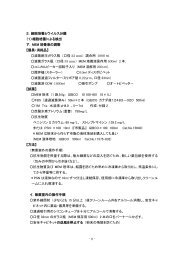Program and Abstracts(PDF)
Program and Abstracts(PDF)
Program and Abstracts(PDF)
You also want an ePaper? Increase the reach of your titles
YUMPU automatically turns print PDFs into web optimized ePapers that Google loves.
Presentation 22<br />
TECHNIQUES FOR CURRENT CONTROL IN TANK; LESSONS LEARNED FROM<br />
REARING LARVAE OF RED SPOTTED GROUPER Epinephelus akaara<br />
Takashi Iwasaki *1 , Masatsugu Takano 2 , Kazuhisa Teruya 3<br />
1 Stock Enhancement Technology Development Center, National Research Institute of<br />
Aquaculture, FRA, Saiki, Oita 879-2602, Japan<br />
2 Research Management Department, Headquarters, FRA, Minato-Mirai, Nishi-ku, Yokohama<br />
220-6115, Japan<br />
3 Stock Enhancement Technology Section, Ishigaki Tropical Station, Seikai National Fisheries<br />
Research Institute, FRA, Fukai-Ohta, Ishigaki, Okinawa 907-0451, Japan<br />
* Email: tak0829 at affrc.go.jp<br />
Mass mortality of the early larval-stage (from hatch to about 10 days after hatching) has been one<br />
of the big constraints during the process of mass fry production in groupers (Epinephelus bruneus,<br />
E. septemfasciatus), bluefin tuna (Thunnus orientalis) or amberjacks (Seriola dumerili, S.<br />
quinqueradiata). A phenomenon associated with the mass mortality is observed that early stage<br />
larvae sink to <strong>and</strong> pile onto tank bottom, <strong>and</strong> the phenomenon, so called “sinking death<br />
syndrome”, has been supposed to be one of the causes of the mass mortality. Many marine fish<br />
appear to show ontogenetic change of larval body density, <strong>and</strong> it is speculated that body density<br />
<strong>and</strong> swimming activity of larvae <strong>and</strong> current condition of rearing tank mutually influence on the<br />
incidence of sinking death. It is indicated that proper current condition is important to prevent the<br />
sinking death syndrome, <strong>and</strong> aeration, submersible pump <strong>and</strong>/or wave-making device have been<br />
practically examined to make the current proper.<br />
In the present study, rearing experiments were conducted in 60 m 3 tanks to investigate the<br />
effects of current control by aeration volumes for preventing the sinking death syndrome of red<br />
spotted grouper larvae. The aeration was done through four porous air hoses (1.5 m in length, 25<br />
mm in diameter) that were set on the tank bottom along the lower edge of each wall. Larvae were<br />
reared different aeration rates (0.25-1.50 L/min/tube), <strong>and</strong> the distribution, feeding amount,<br />
survival <strong>and</strong> growth of larvae were determined. Larvae in the tank with aeration rate of 0.25<br />
L/min/tube showed clearly the sinking performance to tank bottom. Larvae with aeration rate of<br />
1.50 L/min/tube were not remarkably distributed in the lower layer, showing the best survival<br />
without any differences in growth <strong>and</strong> feeding amounts from larvae in the other treatments. Thus,<br />
the present results clearly show that physical environments such as water current inside tanks are<br />
crucial factors to the improvement of survival <strong>and</strong> consequently the establishment of stable/mass<br />
fry production technologies in groupers.<br />
44



